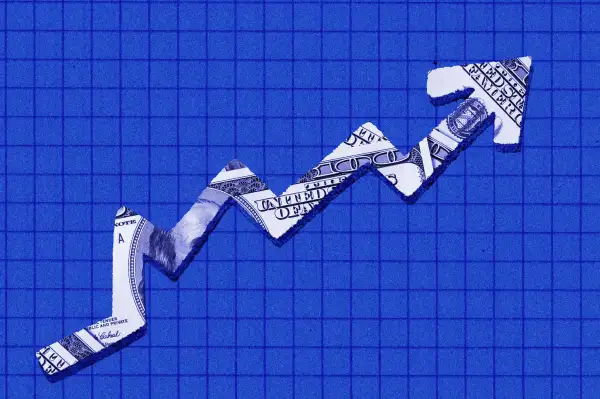Will Sky-High Inflation Tank the Stock Market?
Money is not a client of any investment adviser featured on this page. The information provided on this page is for educational purposes only and is not intended as investment advice. Money does not offer advisory services.

More inflation is coming, and that could mean pain for your portfolio — at least, in the short-run.
Inflation has been a buzzword all year, as supply chain problems and extra saving by U.S. consumers pushed up prices for goods ranging from real estate to cars to bacon. Consumer prices jumped 6.8% in November from a year ago, the fastest clip of price increases since 1982.
So far rising prices have done little to quell a strong rally in the stock market, with the S&P 500 on track for gains of nearly 24%. But that doesn’t mean market participants aren’t worried, particularly as the Federal Reserve has signaled plans to raise interest rates three times in 2022 to help curb price increases.
The biggest risk to the market is a too-aggressive rate hike strategy by central banks followed by inflation, according to a monthly survey of fund managers conducted by Bank of America. Meanwhile, 25% of Americans say rising inflation is the single greatest risk to their retirement plans, a share that has more than doubled since 2020, according to an annual study conducted by Allianz Life Insurance Company of North America.
How much do you need to worry about inflation and the Fed’s accompanying response? Not much. In the short-term, there’s likely to be more market volatility and stock prices could take a hit because borrowing costs have increased and companies may need to absorb the higher costs for raw materials or labor before passing along price increases to their customers.
With time, however, the impact is less obvious because stocks offer a “pretty good hedge” against higher inflation, notes Ross Mayfield, an investment strategy analyst at Baird. “Generally, the stock market has performed quite well over the past 40 to 50 years during periods of higher inflation.”
One notable exception was the 1970s, when stocks fell into a bear market amid a period of stagflation (persistently high inflation accompanied by high unemployment). And because inflation hasn’t been a concern for investors in recent years, some market watchers have pointed to the 1970s as a cautionary tale — a comparison that Mayfield says is unjustified.
“The economic backdrop today is really, really different,” Mayfield notes, adding that the labor market is “as strong as we’ve seen in decades.” As a result, when companies raise prices now, consumers can, by-and-large, “stomach” those price increases to keep spending. “Inflation isn’t something to be feared at all.”
How inflation affects companies
The headline inflation rate obscures some of the wide variations in price increases (or even decreases) across various industries. Just as it’s important for consumers to calculate a “personal” rate of inflation, investors should consider how higher inflation could impact the stocks in your portfolio.
Companies that buy raw materials will immediately feel the pinch of higher commodity prices, while those companies that sell finished goods or offer services may see a delayed effect from the rising costs of transporting items and paying workers. During periods of high inflation and high interest rates, investors typically favor value stocks — including those in the materials, industrials, financials, energy, and consumer staples sectors, Mayfield notes. Some growth stocks, including technology companies, have also performed well in similar periods because they have the ability to pass along price increases to an entrenched customer base, he adds.
While some investors may try to make changes in their portfolio to capture the differing effects of higher inflation, an argument can also be made for focusing on the diversification in your portfolio. “It’s important to really spread your exposure across stocks, bonds and real assets,” advises Eric Freedman, the chief investment officer at U.S. Bank.
Staying invested in the market is also really important, even if stock prices do become more volatile as market participants try to make sense of higher inflation and the Fed’s course for raising interest rates. Freedman and his colleagues forecast that the S&P 500 will end the year at 5,060 — a nearly 9% gain from its current level.
The case for ignoring inflation altogether
Just as the market has seemingly brushed off concerns about inflation this year, there’s a case for investors to do the same. That’s because higher inflation is both a factor of supply and demand issues that are inextricably linked to the pandemic; supply chain issues are partly to blame, while demand has increased partly because of stimulus checks given to Americans.
“It’s hard to separate out traditional inflationary pressures with the cause and effect of pandemic issues,” Mayfield says. This dynamic has also been challenging for central bankers, who initially termed inflation as “transitory” and have pivoted their strategy more recently.
With so much uncertainty still surrounding the pandemic, more volatility is likely to continue as investors make sense of higher inflation and impending higher interest rates. Even so, stocks continue to offer the best return for investors — and Mayfield advises that large-scale portfolio changes aren’t warranted for long-term investors.
“Take a long-term perspective,” Freedman adds. “Have a plan and have an opportunity to revisit that plan as facts change.”
More from Money:
The Hottest New Scene on Campus: Investing Clubs
Investing Has a Whole New Language — Here's Your Cheat Sheet